Multi-Criteria Model for Identifying and Ranking Risky Types of Maritime Accidents Using Integrated Ordinal Priority Approach and Grey Relational Analysis Approach
Abstract
1. Introduction
2. Literature Review
3. Ranking Risky Types of Maritime Accidents
3.1. Accident Data Analysis
3.2. Weight Determination for Three Criteria by an Ordinal Priority Approach (OPA)
3.3. Risk Ranking of Accident Types by the Grey Relational Analysis (GRA)
3.3.1. Normalization of Original Data, if Required
3.3.2. Construction of a Comparative Series
- xi(j) = the value of alternative i under criterion j,
- m = the number of criteria, and
- n = the number of alternatives.
3.3.3. Determination of a Standard Series
3.3.4. Calculation of the Grey Relational Coefficient (GRC:
- ζ is the distinguishing coefficient with ζ ∈ [0, 1], and usually ζ = 0.5 is used.
3.3.5. Assignment of Weights to Criteria
3.3.6. Calculation of the Grey Relational Grade (GRG)
3.3.7. Determination of the Rank of Alternatives
The GRCs Are T
3.4. Discussion
3.4.1. Addition of Criteria
3.4.2. Weight Integration
4. Conclusions
Author Contributions
Funding
Institutional Review Board Statement
Informed Consent Statement
Data Availability Statement
Conflicts of Interest
References
- International Maritime Organization. Revised Guidelines for Formal Safety Assessment (FSA) for Use in the IMO Rule-Making Process; MSC-MEPC.2/Circ.12/Rev.2 9; International Maritime Organization: London, UK, 2018. [Google Scholar]
- Pillay, A.; Wang, J. Technology and Safety of Marine Systems; Elsevier: Amsterdam, The Netherlands, 2003. [Google Scholar]
- Veritas, D.N. Marine Risk Assessment. In Offshore Technology Report 2001/063; HSE Books: Norwich, UK, 2002. [Google Scholar]
- Grdinić-Rakonjac, M.; Antić, B.; Pešić, D.; Pajković, V. Benchmarking Road Safety of Montenegro Using Data Envelopment Analysis. Eur. Transp. Int. J. Transp. Econ. Eng. Law 2019, 73, 2. [Google Scholar]
- Ministry of Employment and Labor. Industrial Accident Statistics in 2002; Ministry of Employment and Labor: Sejong-si, Republic of Korea, 2023. [Google Scholar]
- Köse, E.; Dincer, A.C.; Durukanoglu, H.F. Risk Assessment of Fishing Vessels. Turk. J. Eng. Environ. Sci. 1998, 22, 417–428. [Google Scholar]
- Kim, S.H.; Kim, H.S.; Kang, I.K.; Kim, W.S. An Analysis on Maritime Casualties of Fishing Vessel by FTA Method. J. Korean Soc. Fish. Technol. 2017, 53, 430–436. [Google Scholar] [CrossRef]
- Cho, S.J.; Kim, D.J. A Study on Risk Analysis of Human Loss and Environmental Damage Caused by Hazardous Materials (Oil and HNS) Marine Accidents. J. Korean Soc. Mar. Environ. Saf. 2017, 23, 603–612. [Google Scholar] [CrossRef]
- Antão, P.; Soares, C.G. Analysis of the Influence of Human Errors on the Occurrence of Coastal Ship Accidents in Different Wave Conditions Using Bayesian Belief Networks. Accid. Anal. Prev. 2019, 133, 105262. [Google Scholar] [CrossRef]
- Ung, S.T. Navigation Risk Estimation Using a Modified Bayesian Network Modeling-a Case Study in Taiwan. Reliab. Eng. Syst. Saf. 2021, 213, 107777. [Google Scholar] [CrossRef]
- Hänninen, M.; Banda, O.A.V.; Kujala, P. Bayesian Network Model of Maritime Safety Management. Expert Syst. Appl. 2014, 41, 7837–7846. [Google Scholar] [CrossRef]
- Wu, B.; Zhao, C.; Yip, T.L.; Jiang, D. A Novel Emergency Decision-Making Model for Collision Accidents in the Yangtze River. Ocean Eng. 2021, 223, 108622. [Google Scholar] [CrossRef]
- Kim, T.H.; Kim, D.J.; Jeong, J.H. Analysis of Risk Factor for Marine Leisure Accidents Using Bayesian Network. J. Korean Leis. Sci. 2024, 15, 1–10. [Google Scholar]
- Sur, J.M.; Kim, D.J. Comprehensive Risk Estimation of Maritime Accident Using Fuzzy Evaluation Method—Focusing on Fishing Vessel Accident in Korean Waters. Asian J. Shipp. Logist. 2020, 36, 127–135. [Google Scholar] [CrossRef]
- Massami, E.P. Risk Evaluation Model for Road Traffic Accidents Based on Fuzzy Set Theory. Int. Res. J. Sci. Find. 2014, 1, 201–204. [Google Scholar]
- Liu, Y.; Huang, X.; Duan, J.; Zhang, H. The Assessment of Traffic Accident Risk Based on Grey Relational Analysis and Fuzzy Comprehensive Evaluation Method. Nat. Hazards 2017, 88, 1409–1422. [Google Scholar] [CrossRef]
- Lu, Y. Supply Chain Risk Assessment Based on AHP and Fuzzy Comprehensive Assessment Mode: A Case Study of the Chemical Supply Chain. Int. J. u-e-Serv. Sci. Technol. 2015, 8, 227–234. [Google Scholar] [CrossRef]
- Yang, Z.; Ng, A.K.; Lee, P.T.W.; Wang, T.; Qu, Z.; Rodrigues, V.S.; Lau, Y.Y. Risk and Cost Evaluation of Port Adaptation Measures to Climate Change Impacts. Transp. Res. Part D Transp. Environ. 2018, 61, 444–458. [Google Scholar] [CrossRef]
- Wang, T.; Qu, Z.; Yang, Z.; Nichol, T.; Dimitriui, D.; Clarkel, G.; Bowden, D. How Can the UK Road System be Adapted to the Impacts Posed by Climate Change? By Creating a Climate Adaptation Framework. Transp. Res. Part D Transp. Environ. 2019, 77, 403–424. [Google Scholar] [CrossRef]
- Elmontsri, M. Review of the Strengths and Weaknesses of Risk Matrices. J. Risk Anal. Crisis Response 2014, 4, 49–57. [Google Scholar] [CrossRef]
- Pallis, L.P. Port Risk Management in Container Terminals. Transp. Res. Procedia 2017, 25, 4415–4425. [Google Scholar] [CrossRef]
- Akyildiz, H. Formal Safety Assessment of a Fishing Vessel. Gidb Mag. 2015, 1, 31–46. [Google Scholar]
- Asuelimen, G.; Blanco-Davis, E.; Wang, J.; Yang, Z.; Matellini, D.B. Formal Safety Assessment of a Marine Seismic Survey Vessel Operation, Incorporating Risk Matrix and Fault Tree Analysis. J. Mar. Sci. Appl. 2020, 19, 155–172. [Google Scholar] [CrossRef]
- Peace, C. The Risk Matrix: Uncertain Results? Policy and Practice in Health and Safety; Taylor & Francis: Abingdon, UK, 2017. [Google Scholar]
- Alp, E. Risk Matrices—The Good, the Bad, and the Ugly. In Proceedings of the AWMA Annual Conference, New Orleans, LA, USA, 20–23 June 2006. [Google Scholar]
- Chlomoudis, C.I.; Petros, L.P.; Tzannatos, E.S. Port Risk Assessment Methodology for Human Accidents in Container Terminals: Evidence from the port of Piraeus-Greece. Int. J. Traffic Transp. Eng. 2016, 6, 368–377. [Google Scholar] [CrossRef]
- Kim, D.J.; Sur, J.M.; Cho, H.U. A Long Term Expected Risk Estimation of Maritime Accidents through Markov Chain Approach and Probabilistic Risk Matrix. Asian J. Shipp. Logist. 2023, 39, 1–12. [Google Scholar] [CrossRef]
- Xu, M.; Ma, X.; Zhao, Y.; Qiao, W. A Systematic Literature Review of Maritime Transportation Safety Management. J. Mar. Sci. Eng. 2023, 11, 2311. [Google Scholar] [CrossRef]
- Wang, J.J.; Jing, Y.Y.; Zhang, C.F.; Zhao, J.H. Review on Multi-Criteria Decision Analysis Aid in Sustainable Decision-Making. Renew. Sustain. Energy Rev. 2009, 13, 2263–2278. [Google Scholar] [CrossRef]
- Janackovic, G.; Savic, S.; Stankovic, M. Multi-Criteria Decision Analysis in Occupational Safety Management Systems. Saf. Eng. 2011, 1, 17–22. [Google Scholar] [CrossRef]
- Alinezhad, A.; Khalili, J. New Methods and Applications in Multiple Attribute Decision Making (MADM); Springer: Berlin/Heidelberg, Germany, 2019. [Google Scholar]
- Sur, J.M.; Kim, D.J. Multi Criteria Evaluation of Beneficial Effect of Commercializing Northern Sea Route on Europe and Asia countries. Asian J. Shipp. Logist. 2020, 36, 193–201. [Google Scholar] [CrossRef]
- Liu, Z.; Wu, Z. The Identification of Human Unsafe Acts in Maritime Accidents with Grey Relational Analysis; ANC: Johannesburg, South Africa, 2004. [Google Scholar]
- Su, D.T.; Tzu, F.M.; Cheng, C.H. Investigation of Oil Spills from Oil Tankers through Grey Theory: Events from 1974 to 2016. J. Mar. Sci. Eng. 2019, 7, 373–386. [Google Scholar] [CrossRef]
- Wang, H.C.; Lee, H.S. Application of Grey Relational Analysis to Evaluate Port Safety in Keelung Harbor. J. Ship Prod. Des. 2010, 26, 206–210. [Google Scholar] [CrossRef]
- Nayakappa, P.A.; Gaurish, A.; Mahesh, G. Grey Relation Analysis Methodology and its Application. Res. Rev. Int. J. Multidiscip. 2019, 4, 409–411. [Google Scholar]
- Hsiao, S.W.; Lin, H.H.; Ko, Y.C. Application of Grey Relational Analysis to Decision Making during Product Development. J. Math. Sci. Technol. Educ. 2017, 13, 2581–2600. [Google Scholar] [CrossRef]
- Lo, H.W.; Liou, J.J.H. A Novel Multiple-Criteria Decision-Making-based FMEA Model for Risk Assessment. Appl. Soft Comput. J. 2018, 73, 684–696. [Google Scholar] [CrossRef]
- Xu, Q.; Xu, K. Mine Safety Assessment using Gray Relational Analysis and Bow Tie Model. PLoS ONE 2018, 13, e0193576. [Google Scholar] [CrossRef]
- Stanujkic, D.; Dordevic, B.; Dordevic, M. Comparative Analysis of Some Prominent MCDM Methods: A Case of Ranking Serbian Banks. Serbian J. Manag. 2013, 8, 213–241. [Google Scholar] [CrossRef]
- Yu, T.; Wu, C. A Grey Relational Analysis of the Influence Factors of Tourism Industry in Guangdong Province. In Proceedings of the 2nd International Conference on Humanities and Social Science Research, Singapore, 29–31 July 2016; pp. 135–139. [Google Scholar]
- Cai, J. Grey Relational Analysis of Regional Logistics and Economies in Jiangxi Province. Rev. Fac. Ing. UCV 2017, 32, 64–68. [Google Scholar]
- Malek, A.; Ebrahminejad, S.; Mohaddam, R.T. An Improved Hybrid Grey Relational Analysis Approach for Green Resilient Supply Chain Network Assessment. Sustainability 2017, 9, 1433. [Google Scholar] [CrossRef]
- GrdiniĆ-Rakonjac, M.; AntiĆ, B.; PeŠiĆ, D.; PajkoviĆ, V. Construction of Road Safety Composite Indicator using Grey Relational Analysis. Traffic Transp. 2021, 33, 103–116. [Google Scholar] [CrossRef]
- Dominguez-Péry, C.; Vuddaraju, L.N.R.; Corbett-Etchevers, I.; Tassabehji, R. Reducing Maritime Accidents in Ships by Tackling Human Error: A Bibliometric Review and Research Agenda. J. Shipp. Trade 2021, 6, 1–32. [Google Scholar] [CrossRef]
- Ataei, Y.; Mahmoudi, A.; Feylizadeh, M.R.; Li, D.F. Ordinal Priority Approach (OPA) in Multiple Attribute Decision-Making. Appl. Soft Comput. J. 2020, 86, 105893. [Google Scholar] [CrossRef]
- Dulmin, R.; Mininno, V. Supplier Selection using a Multi-Criteria Decision Aid Model. J. Purch. Supply Manag. 2003, 9, 177–187. [Google Scholar] [CrossRef]
- Amid, A.; Ghodsypour, S.H.; O’Brien, C. Fuzzy Multi Objective Linear Model for Supplier Selection in a Supply Chain. Int. J. Prod. Econ. 2006, 104, 394–407. [Google Scholar] [CrossRef]
- Asgharpour, M.J. Group Decision Making and Game Theory in Operation Research; Tehran University Press: Tehran, Iran, 2003. [Google Scholar]
- Ju-Long, D. Control Problems of Grey Systems. Syst. Control Lett. 1982, 1, 288–294. [Google Scholar] [CrossRef]
- Sallehuddin, R.; Shamsuddin, S.M.H.; Hashim, S.Z.M.; Skudai, J.; Roselina, M. Grey Relational Analysis and Its Application on Multivariate Time Series. In Proceedings of the IEEE International Conference on Intelligent Systems Design and Applications, Vellore, India, 6–8 December 2018; pp. 1–8. [Google Scholar]
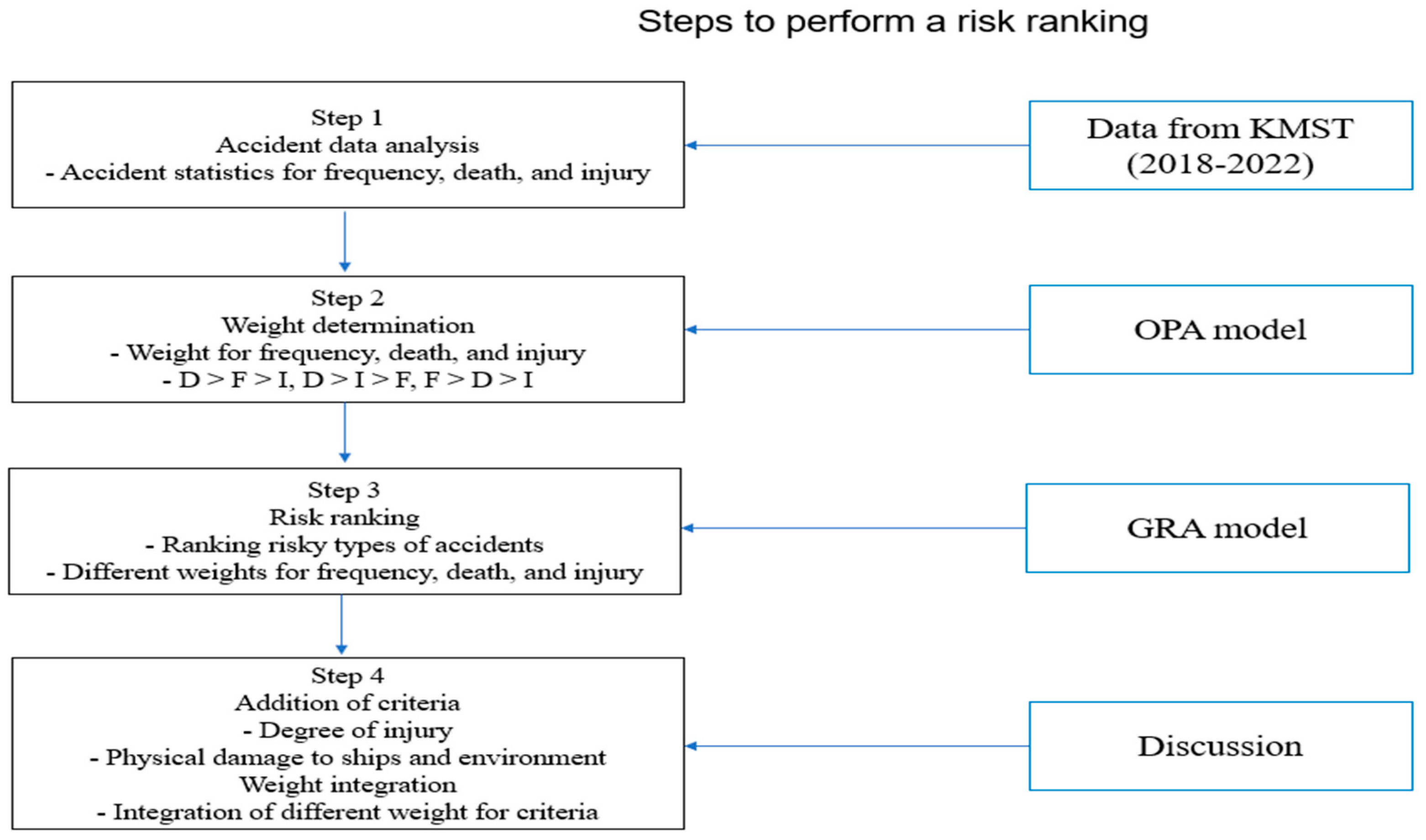
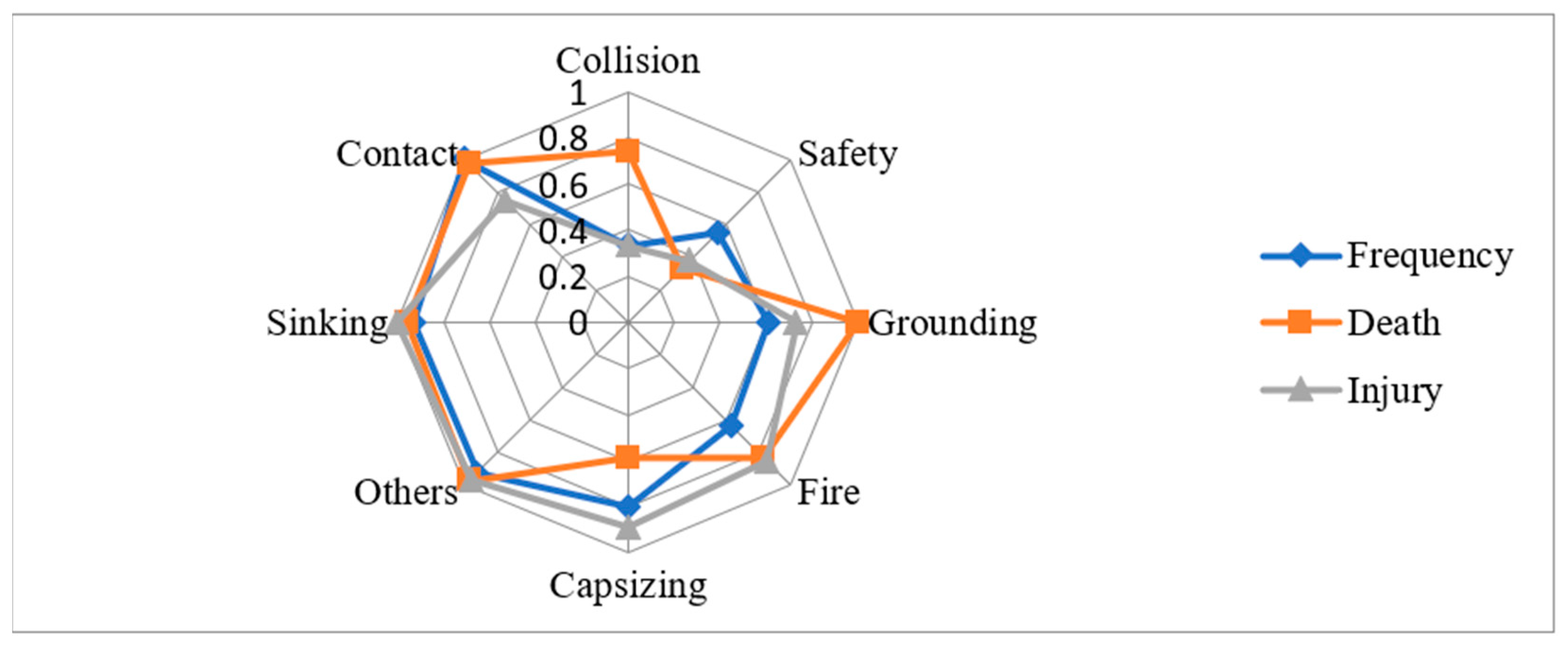
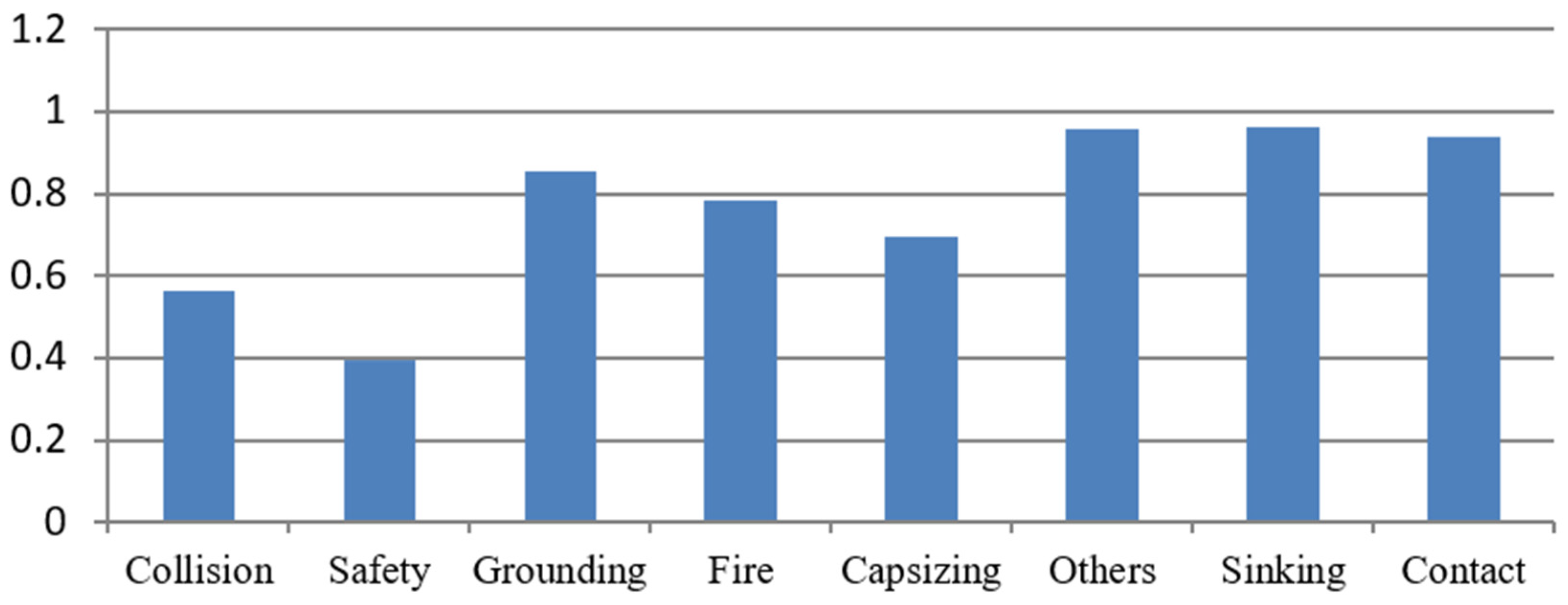
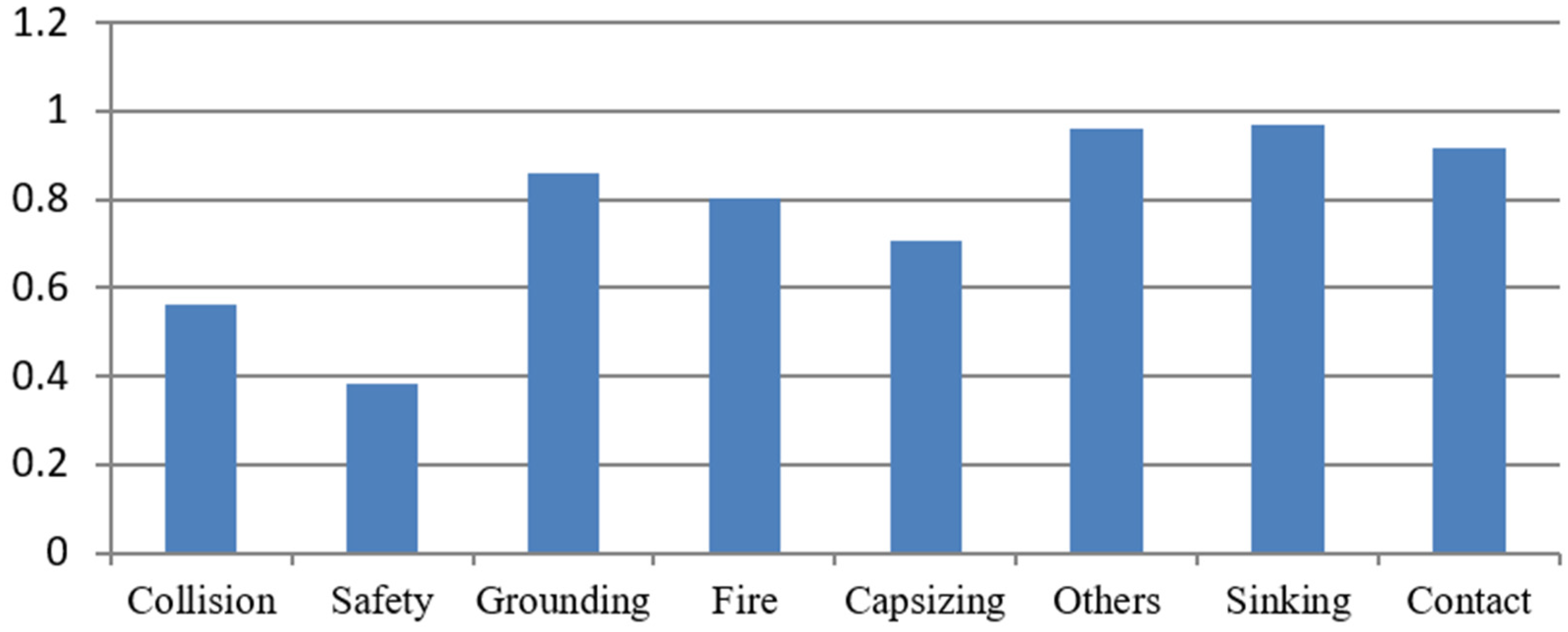
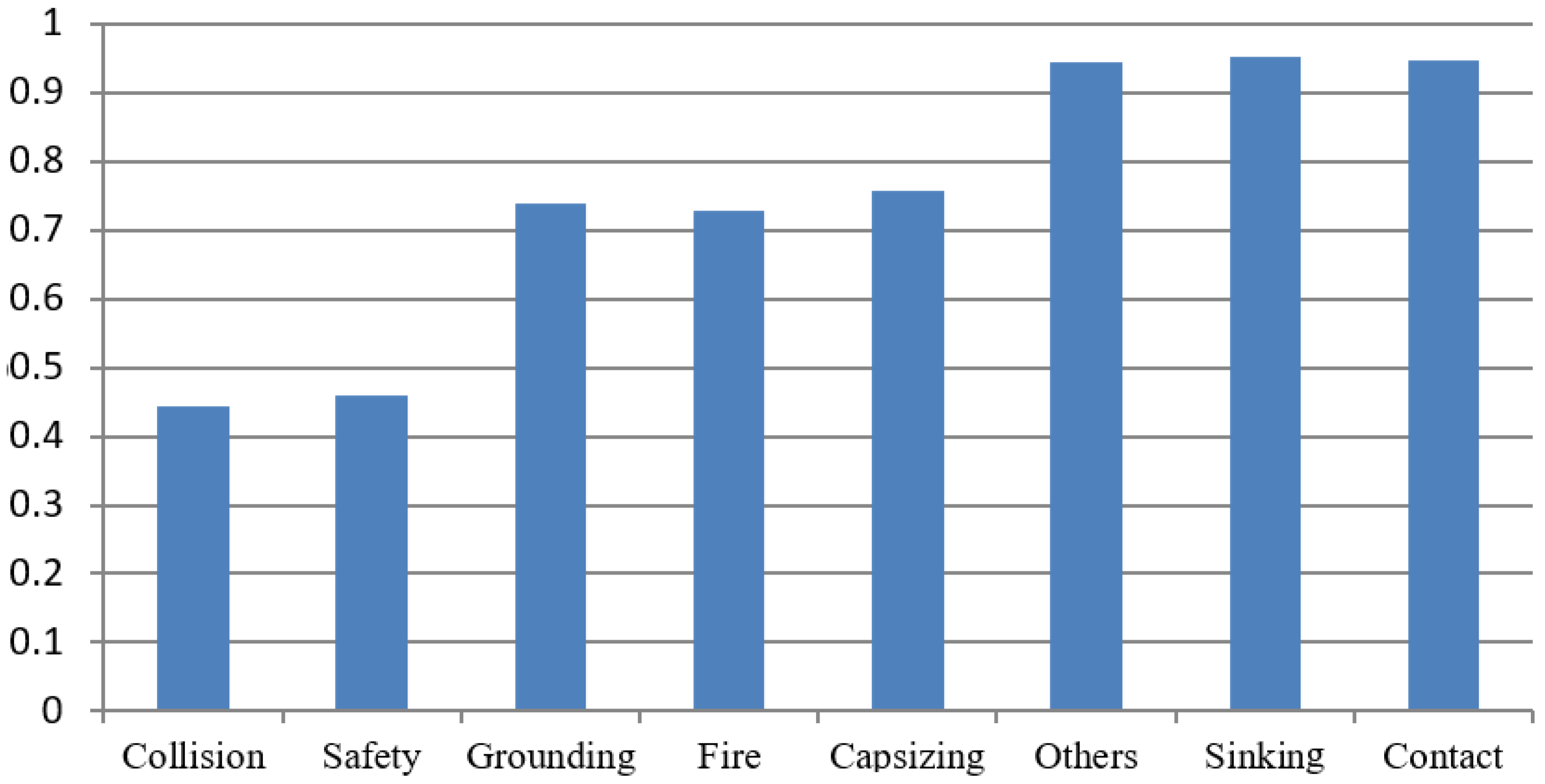
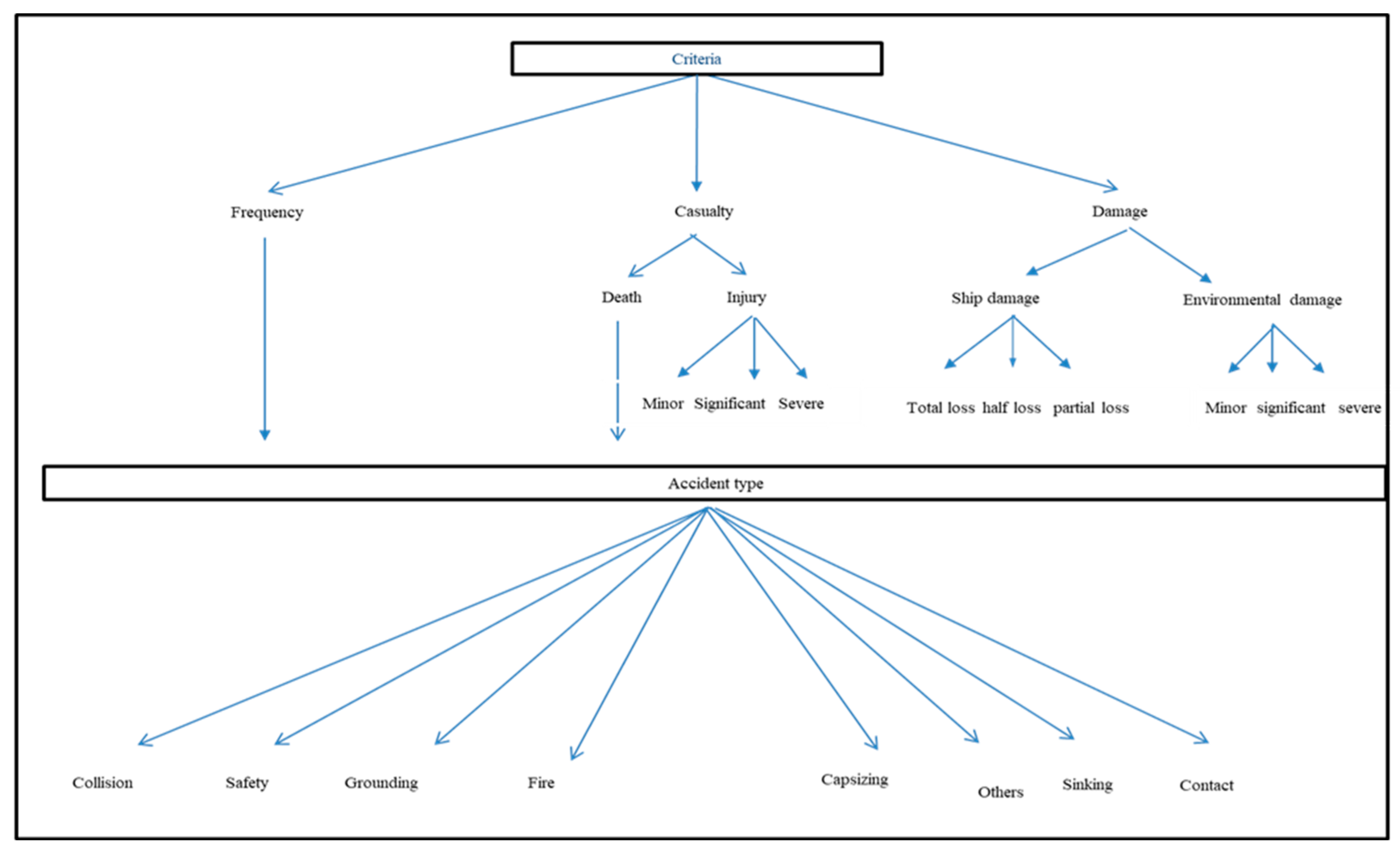
| Risk Index | |||||
|---|---|---|---|---|---|
| Severity (Consequence) | |||||
| CI 1 | 2 | 3 | 4 | ||
| FI | Frequency | Minor (0.01) | Significant (0.1) | Severe (1) | Catastrophic (10) |
| 7 | Frequent | 8 | 9 | 10 | 11 |
| 6 | 7 | 8 | 9 | 10 | |
| 5 | Reasonably Probable | 6 | 7 | 8 | 9 |
| 4 | 5 | 6 | 7 | 8 | |
| 3 | Remote | 4 | 5 | 6 | 7 |
| 2 | 3 | 4 | 5 | 6 | |
| 1 | Extremely Remote | 2 | 3 | 4 | 5 |
| FTA-ETA | Risk Matrix | Fuzzy Set | OPA-GRA | |
|---|---|---|---|---|
| Tool | Probability | Numerical value or linguistic expression | Membership functions | Mathematical formula |
| Criteria | Frequency Fatality | Frequency Fatality | Frequency fatality | Frequency Fatality Injury |
| Extension to multiple criteria | No | No | Possible | Yes |
| Weight | No | No | No | Yes (OPA) |
| Risk result | Numerical value | Numerical value | Numerical value or linguistic expression | Risk ranking (GRA) |
| Risk assessment criteria | ALARP principle | ALARP principle | ALARP principle | Not required |
| Risk reduction measures | Hard to identify the priority | Hard to identify the priority | Hard to identify the priority | Easy to identify the priority |
| Frequency (Ranking) | Death (Ranking) | Injury (Ranking) | |
|---|---|---|---|
| Collision | 1684 (1) | 46 (3) | 605 (1) |
| Safety | 731 (2) | 255 (1) | 498 (2) |
| Grounding | 586 (3) | 2 (8) | 119 (3) |
| Fire | 537 (4) | 28 (4) | 62 (5) |
| Capsizing | 282 (5) | 90 (2) | 48 (6) |
| Others | 141 (6) | 6 (6) | 20 (7) |
| Sinking | 137 (7) | 7 (5) | 9 (8) |
| Contact | 77 (8) | 5 (7) | 108 (4) |
| Order of Importance | Death | Frequency | Injury |
|---|---|---|---|
| D > F > I | 0.567208 | 0.243722 | 0.189068 |
| D > I > F | 0.558142 | 0.162791 | 0.279069 |
| F > D > I | 0.272934 | 0.545109 | 0.181956 |
| Accident Type | Frequency | Death | Injury |
|---|---|---|---|
| Standard series | 1 | 1 | 1 |
| Collision | 0 | 0.826087 | 0 |
| Safety | 0.59303 | 0 | 0.17953 |
| Grounding | 0.683261 | 1 | 0.815436 |
| Fire | 0.713752 | 0.897233 | 0.911074 |
| Capsizing | 0.872433 | 0.652174 | 0.934564 |
| Others | 0.960174 | 0.98419 | 0.981544 |
| Sinking | 0.962663 | 0.980237 | 1 |
| Contact | 1 | 0.988142 | 0.833893 |
| Accident Type | Frequency | Death | Injury |
|---|---|---|---|
| Collision | 0.333333 | 0.741935 | 0.333333 |
| Safety | 0.551286 | 0.333333 | 0.378653 |
| Grounding | 0.61219 | 1 | 0.730392 |
| Fire | 0.635932 | 0.829508 | 0.849003 |
| Capsizing | 0.796728 | 0.589744 | 0.884273 |
| Others | 0.926225 | 0.969349 | 0.964401 |
| Sinking | 0.930515 | 0.961977 | 1 |
| Contact | 1 | 0.976834 | 0.75063 |
| Accident Type | GRG | Ranking | Weights for Criteria |
|---|---|---|---|
| Collision | 0.565095 | 2 | Death 0.567208 Frequency 0.243722 Injury 0.189068 |
| Safety | 0.395021 | 1 | |
| Grounding | 0.854506 | 5 | |
| Fire | 0.786014 | 4 | |
| Capsizing | 0.695875 | 3 | |
| Others | 0.957901 | 7 | |
| Sinking | 0.961496 | 8 | |
| Contact | 0.93971 | 6 |
| Accident Type | GRG | Ranking | Weights for Criteria |
|---|---|---|---|
| Collision | 0.561391 | 2 | Death 0.567208 Frequency 0.162791 Injury 0.279069 |
| Safety | 0.381461 | 1 | |
| Grounding | 0.861629 | 5 | |
| Fire | 0.803436 | 4 | |
| Capsizing | 0.705633 | 3 | |
| Others | 0.960948 | 7 | |
| Sinking | 0.967467 | 8 | |
| Contact | 0.917473 | 6 |
| Accident Type | GRG | Ranking | Weight for Criteria |
|---|---|---|---|
| Collision | 0.444854 | 1 | Death 0.272934 Frequency 0.545109 Injury 0.181956 |
| Safety | 0.460387 | 2 | |
| Grounding | 0.739544 | 4 | |
| Fire | 0.727534 | 3 | |
| Capsizing | 0.756163 | 5 | |
| Others | 0.944940 | 6 | |
| Sinking | 0.951744 | 8 | |
| Contact | 0.948301 | 7 |
| Weight | Collision | Safety | Grounding | Fire | Capsizing | Others | Sinking | Contact |
|---|---|---|---|---|---|---|---|---|
| D > F > I | 2 | 1 | 5 | 4 | 3 | 7 | 8 | 6 |
| D > I > F | 2 | 1 | 5 | 4 | 3 | 7 | 8 | 6 |
| F > D > I | 1 | 2 | 4 | 3 | 5 | 6 | 8 | 7 |
| Accident Type | Main Cause | Number of Accidents | Number of Total Accidents | Ratio of Accidents |
|---|---|---|---|---|
| Collision | Negligence of look out forward | 425 | 469 | 0.906183 |
| Safety | Violation of safety regulations | 139 | 159 | 0.874214 |
| Grounding | Negligence of confirming position | 44 | 51 | 0.862745 |
| Fire | Defect in ship or engine system | 28 | 67 | 0.41791 |
| Capsizing | Unsafe loading of cargo | 7 | 17 | 0.411765 |
| Others | Unsafe operation of engine system | 17 | 53 | 0.320755 |
| Sinking | Improper management of ship operation | 11 | 76 | 0.144737 |
| Contact | Improper ship design and building | 29 | 102 | 0.284314 |
| Equation (15) | Equation (16) | Weight Range | |
|---|---|---|---|
| Death | 0.751637 | 0.472677 | (0.272934, 0.567208) |
| Frequency | 0.164849 | 0.306236 | (0.162791, 0.545109) |
| Injury | 0.083514 | 0.221086 | (0.181956, 0.279069) |
Disclaimer/Publisher’s Note: The statements, opinions and data contained in all publications are solely those of the individual author(s) and contributor(s) and not of MDPI and/or the editor(s). MDPI and/or the editor(s) disclaim responsibility for any injury to people or property resulting from any ideas, methods, instructions or products referred to in the content. |
© 2024 by the authors. Licensee MDPI, Basel, Switzerland. This article is an open access article distributed under the terms and conditions of the Creative Commons Attribution (CC BY) license (https://creativecommons.org/licenses/by/4.0/).
Share and Cite
Sur, J.-M.; Kim, Y.-J. Multi-Criteria Model for Identifying and Ranking Risky Types of Maritime Accidents Using Integrated Ordinal Priority Approach and Grey Relational Analysis Approach. Sustainability 2024, 16, 6023. https://doi.org/10.3390/su16146023
Sur J-M, Kim Y-J. Multi-Criteria Model for Identifying and Ranking Risky Types of Maritime Accidents Using Integrated Ordinal Priority Approach and Grey Relational Analysis Approach. Sustainability. 2024; 16(14):6023. https://doi.org/10.3390/su16146023
Chicago/Turabian StyleSur, Ji-Min, and Young-Ju Kim. 2024. "Multi-Criteria Model for Identifying and Ranking Risky Types of Maritime Accidents Using Integrated Ordinal Priority Approach and Grey Relational Analysis Approach" Sustainability 16, no. 14: 6023. https://doi.org/10.3390/su16146023
APA StyleSur, J.-M., & Kim, Y.-J. (2024). Multi-Criteria Model for Identifying and Ranking Risky Types of Maritime Accidents Using Integrated Ordinal Priority Approach and Grey Relational Analysis Approach. Sustainability, 16(14), 6023. https://doi.org/10.3390/su16146023







